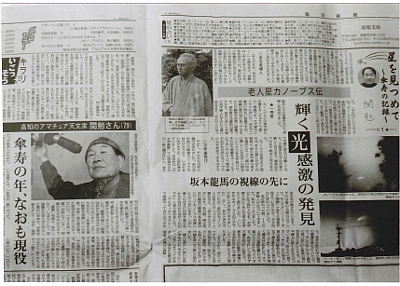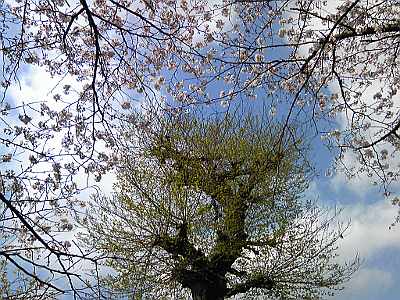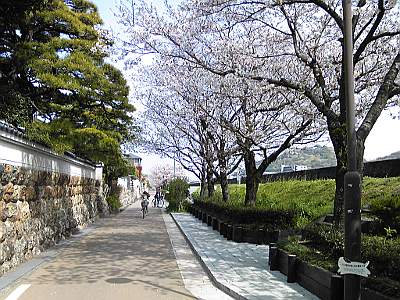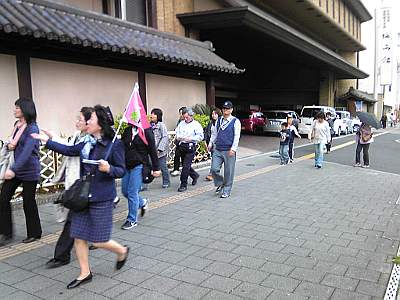April 24, 2010
Arranged by Mr. Senwaki of Mainichi Shinbun Newspaper Kochi
office, a serial about the stars began in April for next one year, which
is to be published every Wednesday of the week. The photograph below is
that of the first of the serial spread over two pages in the April 1st
Kochi edition of Mainichi Shinbun. The title of the article is "Gazing
at the Stars", which I often use for lectures.

The April 1st 2010 Kochi edition of Mainichi Shinbun
The articles are, as you expect, based on a true story, but
I made it as interesting and enjoyable as I possibly could with the newspaper
readers in mind. Consequently, it may slightly deviate from the truth.
In my articles I often refer to Juza Unno's sci-fi "the
Martian Army" published in the school children's edition of Mainichi
Shinbun. I read the story when I was at elementary school and cannot forget
the excitement I experienced 60 long years ago. Ryoma, a very popular figure
on TV, also appears often in my articles. The Martian created by Unno will
appear in a future article, but I think I ran into a person closely resembling
that Martian (an alien?) at the hill where the observatory stands. I hope
you enjoy the 50 installments of the serial.

A Martian drawn by Juza Unno
Reproduced from Mainichi Shinbun for School Children in 1940
April 5, 2010
Cherry blossoms are in full bloom now in Kamimachi, where
my home is located. Kamimachi used to be called "Tsukiyashiki-machi
is a quiet residential area along Kagamigawa River. There are about 100
cherry trees along the banks of the river. They are the last to blossom
in Kochi city.
The Kendo (swordsmanship) school Ryoma went to in his youth
is thought to be situated in the neighborhood photographed here. The house
with the magnificent stone walls belongs to a person called Yamasaki, who
taught at Tosa Girls' Junior High School. About 10 years ago, I would see
Mr. Yamasaki when I was walking my dog.
Around 1948, a naked-eye comet called McGann (the eclipse
comet of 1948) appeared in the predawn sky and immediately they provided
a description of the comet on the radio. Newspapers also reported the appearance
of the comet on the following morning. The comet was closely observed and
they provided the description of the coma and nucleus as well as the angular
measure of the length of the tail. Unfortunately, I was just a beginner
at that time and missed this great comet.
Thirteen years later, when I discovered Comet Seki 1961 R1,
I received a letter from Mr. Yamasaki in which he talked about comets he
had seen many years before. He wrote he would like to look through my telescope,
but the opportunity didn't arise. We didn't even have a chance to have
a chat, either. It is quiet around his house and nobody seems to be living
there. These days the population of this residential area is decreasing.
It was so quiet here that I could almost hear falling flowers drop on the
ground.
April 4, 2010
A large number of tourists are visiting Kochi city now because
of Tosa & Ryoma Expo being held in the city as well as the popularity
of NHK TV's drama "Ryoma-den" (the story of Ryoma). As Ryoma's
birthplace is situated in the Kamimachi area, where I live, groups of visitors
on guided tours are often seen. In Kamimachi, there are facilities associated
with Ryoma such as Ryoma's birthplace, the site where Ryoma's ancestors
were running a store called "Saitaniya", Tsukiyashiki-machi where
Ryoma went to a Kenjutsu (swordsmanship) school in his younger days, as
well as the recently completed Ryoma Museum. They are all within 5 minutes'
walk from home. There is also Ryoma Post Office, but this has nothing to
do with Ryoma. It was so named simply because of its location next to Ryoma's
birthplace along the streetcar line. Ryoma's statue at the post office
entrance greets you.
No. 4 Elementary School I went to is also near Ryoma's birthplace.
There is Ryoma's famous portrait displayed in the school master's office.
It was very large and painted by a famous painter. It used to be hung on
the tall wall of the auditorium. On certain occasions we gathered there
to listen to what the school master had to say or see movies under Ryoma's
gaze. Even in our early childhood, we were impressed that Ryoma was a great
figure who had ushered in "the dawn of modern Japan". No.4 Elementary
School has 120-year long history and turned out many prominent figures.





